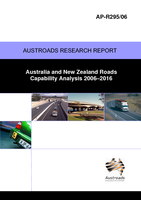Agency Management

Australia and New Zealand Roads Capability Analysis 2006-2016
- Publication no: AP-R295-06
- ISBN: 1 921139 79 X
- Published: 20 November 2006
- PDF (free) Download
Future skilled labour supply in Australia and New Zealand is not likely to be sufficient in meeting forecast demand in the roads sector, based on forecast construction, maintenance and road management activity, and taking into account labour lost through workforce attrition. This report presents an analysis of the capability of the Australian and New Zealand skilled roads workforce to meet infrastructure development requirements over the decade to 2015/16.
- AP-R295/06 Australia and New Zealand Roads Capability Analysis 2006–2016
- CONTENTS
- TABLES AND CHARTS
- EXECUTIVE SUMMARY
- 1. INTRODUCTION
- 1.1. Project outline
- 1.2. Structure of this report
- 2. STRUCTURE OF THE FORECASTING MODEL
- 2.1. Project scope and methodology
- 2.2. Defining the current skilled roads workforce
- 2.3. Forecasting future skilled labour demand
- 2.4. Modelling existing workforce attrition
- 2.5. Modelling new graduate supply
- 2.6. Limitations of the model and summary of key assumptions
- 3. ECONOMIC AND CONSTRUCTION SECTOR OUTLOOK
- 3.1. Economic outlook
- 3.2. Building outlook
- 3.3. Engineering construction
- 3.4. Road construction and maintenance
- 4. AUSTRALIA
- 4.1. Estimate of the skilled roads workforce
- 4.2. Forecasts of skilled labour demand
- 4.3. Workforce attrition and the workforce gap
- 4.4. Graduate supply and the capability deficit
- 4.5. Interpretation of results
- 5. NEW SOUTH WALES
- 5.1. The skilled roads workforce
- 5.2. Roads activity outlook
- 5.3. Forecasts of skilled labour demand
- 5.4. Workforce attrition and the workforce gap
- 6. VICTORIA
- 6.1. The skilled roads workforce
- 6.2. Roads activity outlook
- 6.3. Forecasts of skilled labour demand
- 6.4. Workforce attrition and the workforce gap
- 7. QUEENSLAND
- 7.1. The skilled roads workforce
- 7.2. Roads activity outlook
- 7.3. Forecasts of skilled labour demand
- 7.4. Workforce attrition and the workforce gap
- 8. SOUTH AUSTRALIA
- 8.1. The skilled roads workforce
- 8.2. Roads activity outlook
- 8.3. Forecasts of skilled labour demand
- 8.4. Workforce attrition and the workforce gap
- 9. WESTERN AUSTRALIA
- 9.1. The skilled roads workforce
- 9.2. Roads activity outlook
- 9.3. Forecasts of skilled labour demand
- 9.4. Workforce attrition and the workforce gap
- 10. TASMANIA
- 10.1. The skilled roads workforce
- 10.2. Roads activity outlook
- 10.3. Forecasts of skilled labour demand
- 10.4. Workforce attrition and the workforce gap
- 11. NORTHERN TERRITORY
- 11.1. The skilled roads workforce
- 11.2. Roads activity outlook
- 11.3. Forecasts of skilled labour demand
- 11.4. Workforce attrition and the workforce gap
- 12. AUSTRALIAN CAPITAL TERRITORY
- 12.1. The skilled roads workforce
- 12.2. Roads activity outlook
- 12.3. Forecasts of skilled labour demand
- 12.4. Workforce attrition and the workforce gap
- 13. NEW ZEALAND
- 13.1. A note on New Zealand data
- 13.2. The skilled roads workforce
- 13.3. Forecasts of skilled labour demand
- 13.4. Workforce attrition and the workforce gap
- 13.5. Graduate supply and the capability deficit
- 13.6. Interpretation of results
- 14. SUMMARY AND RECOMMENDATIONS FOR FUTURERESEARCH
- 14.1. Summary of key points
- 14.2. Recommendations for future research
- BIBLIOGRAPHY
- INFORMATION RETRIEVAL
Related publications
WEB-AP-R677-22
Latest Agency Management News
